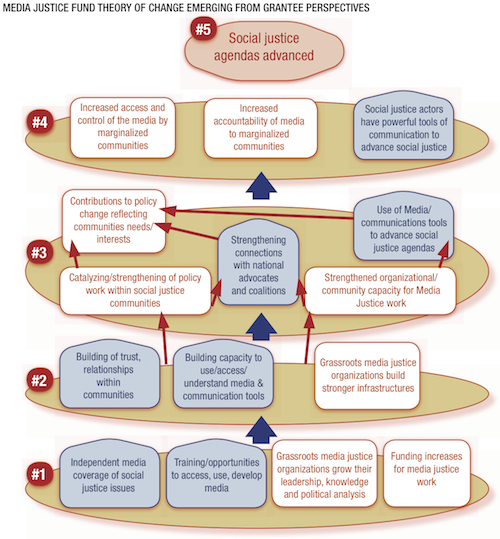Learning from the Media Justice Fund
While the Media Justice Fund of the Funding Exchange has closed its doors, their 6 years of history, impact and thoughts for the future have been summarized in a great 46-page Final Evaluation. I’m struck by the depth of thought and engagement that went into this evaluation as well as its honest practice in exposing both the strengths and difficulties of building capacity in the sector.
Many of its questions and recommendations resonate strongly here at the Transmission Project:
POLICY CHANGE VS. SOCIAL CHANGE?
Whether intended or not, the MJF prioritized short-term policy outcomes. While there needed to be opportunities to fund discrete political opportunities, the work of building constituency and citizen engagement needed to be prioritized. The difficulty around this is that the Funding Exchange (or any funder) needs to be comfortable with, and able, to declare community and movement building outcomes as legitimate milestones on the way to longer term change.RESOURCE LIMITATIONS AND FUNDING STRATEGY
With limited funds to grant, should the funder be more selective of who is funded? Is there a way to take resource realities into consideration, while still reflecting the overall value the MJF has provided, as demonstrated in this assessment? Informants made a number of specific recommendations which included: Funding for specific collaborative projects, that have the greater likelihood of “going to scale”CONVENING, NETWORKING, SUPPORT ROLE:
The MJF role of convening, and providing opportunities for networking, peer exchanges, and learning, is effective. The careful process focus involved in efforts to link national efforts was found to be of particular value. A key element of this is the facilitation, support and assistance—“hand holding,” in some cases—played by MJF program staff (in particular Hye-Jung Park). These MJF staff brought to the table a personal alignment and understanding of the values and strategies of social justice organizing. They displayed a familiarity with national political players and dynamics and paid careful attention to the process of building relationships and opportunities for learning. A number of grantees suggested that the more experienced grantees could be available to mentor the less experienced ones.COMMUNICATION STRATEGY CANNOT BE AN AFTERHOUGHT:
Given the difficulty articulating and making the case for grassroots and local organizing, the promotion of grantees’ progress needs to be prioritized. Consider new communications tools (You-tube, etc.,) for illustrating powerful case studies and examples. This is related to the above strategy [of short-term and long-term goals] – when there is “confusion” or “tension” around how “success” is defined by the program, it is unlikely that these “success stories” will rise up to the surface.YOU NEED CAPACITY TO BUILD CAPACITY
Funding emerging organizations and helping them move to the next level requires the capacity to give adequate technical support, both in organizational development (staff and board development, fundraising, financial management), and in political strategy, coalition development, etc. It is unlikely that all of this can be provided by the same staff person, especially with a significant number of grantees. We note too that the staff need to plan the time and resources required for developing the relationships with grantees so that the TA provided will fit their individual needs. Finally, building capacity requires initial strong commitment from board and staff of the whole organization. You need more than staff buy-in.
The graphic for this post is the Theory of Change as articulated by the Media Justice Fund’s grantees. View the Large Version.




Comments
Post new comment